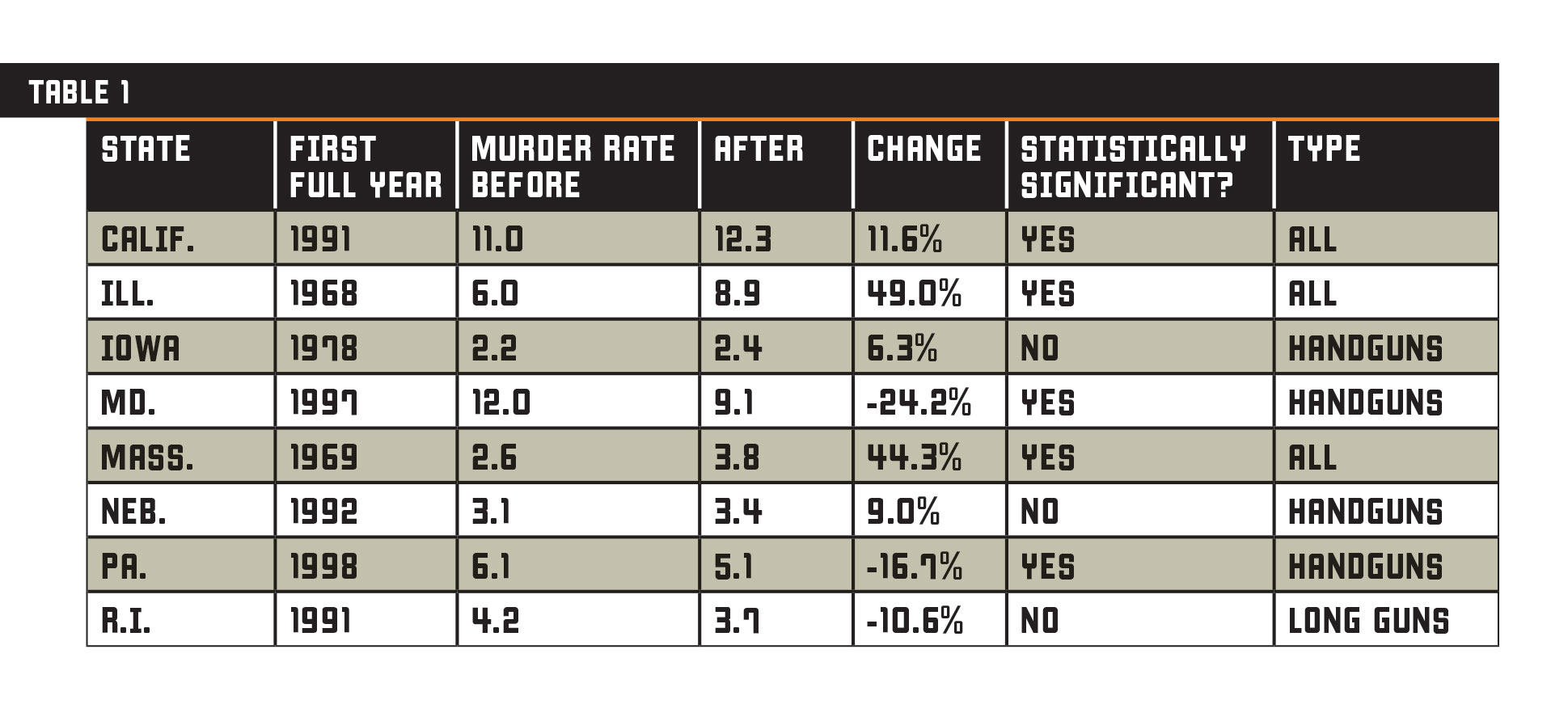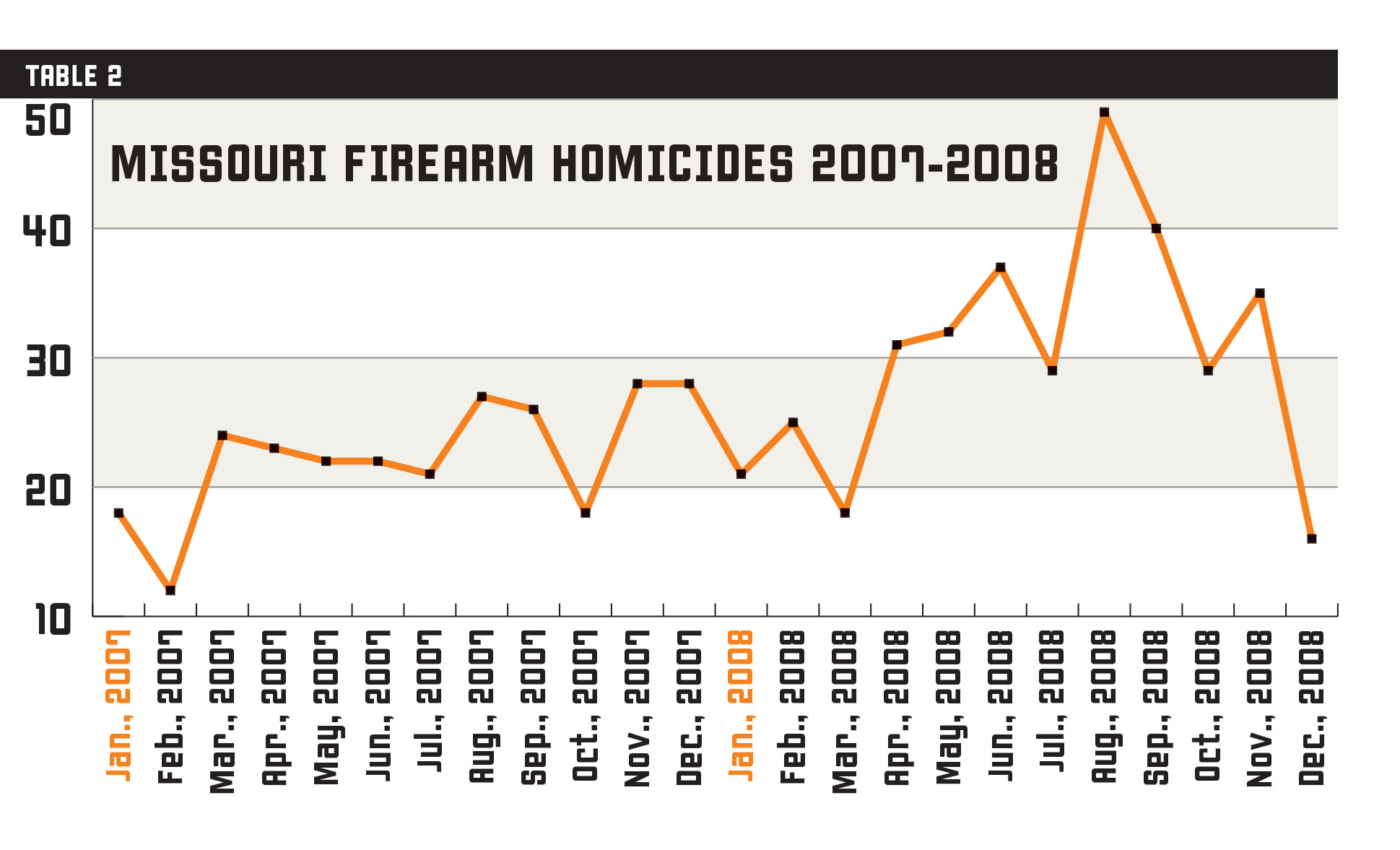
Originally appeared in America’s 1st Freedom magazine, August 2013.
National mandatory background checks for all private party firearm sales are again part of the national conversation. There are people who everyone agrees should not be able to buy a gun—convicted violent criminals and those currently awaiting trial or sentencing for such crimes, illegal aliens, people with serious mental illness problems.
If the background check was free, fast, and did not produce any gun or gun owner registration lists, it would likely face less opposition from gun rights advocates. But such a system is a far cry from recent proposals.
I will let others argue if there is a way to create such a system, because I have a more serious question to ask: Do mandatory background checks reduce murder rates? If they do not, or if they make very little difference, perhaps the national conversation should turn toward something that actually can reduce murder rates.
There are a number of states that have mandatory private party firearm background checks right now. A few states have for a number of years required such a check for any firearm transfer: California, Hawaii, Illinois, Massachusetts, New Jersey and Rhode Island. A few other states have for many years required such a check to transfer a handgun: Maryland, Iowa, Michigan, Nebraska, New York, North Carolina and Pennsylvania. In addition, one state—Missouri—recently repealed its requirement for such background checks for handguns.If the background check was free, fast, and did not produce any gun or gun owner registration lists, it would likely face less opposition from gun rights advocates. But such a system is a far cry from recent proposals.
In some states, the background check is part of the process of obtaining a permit from the sheriff or police department to purchase a firearm. In other states, to purchase a firearm you must possess a firearms owner identification card that, again, requires a background check. A few states have odd rules that approach a mandatory check, but leave many exceptions. Oregon and Connecticut (until this year) required a background check for all private party firearms transfers at gun shows, but not elsewhere. Minnesota has a really oddball law that, at first glance, looks like a mandatory background check for privately sold handguns and so-called “assault weapons,” but it really isn’t. There, a transfer without a background check is only illegal if the recipient uses the gun in certain types of crime within a year—and even then, only if the buyer was prohibited by law from having the gun, or if the crime was “reasonably foreseeable.”
Let’s examine what happened to murder rates in states that adopted mandatory private party firearms background checks (and in Missouri, which did just the opposite). Did murder rates go up or down after these laws went into effect?
One method for measuring this is called interrupted time series analysis (ITSA), which compares the average of crime rates for several years before and after a change in a law. Like most methods that compare changes in two variables to determine if one influences the other, this is a fairly crude tool. If a law has a very subtle influence on behavior, applying ITSA to a single state will not tell you very much.
Another problem is if there are other changes to the state’s laws that take place at the same time as adoption of the background check law, it is difficult to determine which law actually might have caused a change in murder rates. However, if multiple states pass a background check law in different years, and you see similar changes in crime rates in most cases, it may be a good indicator that the law affects crime rates. If different states get different results, and there is no consistent pattern, it may be an indicator that the law either does nothing, or its effects are very subtle.
Unfortunately, the only particularly trustworthy and consistent data on murder rates for U.S. states are those collected by the FBI Uniform Crime Reports program, started in 1960. The FBI may not be always correct, but the odds are that it is at least consistent, making it useful for this sort of study. Because many of the mandatory background check laws took effect before 1960, these states really aren’t going to be useful for ITSA. One interesting exception: Rhode Island’s mandatory background check for handguns dates back at least to 1956, so we can’t really do an ITSA on that law. But the background check requirement for long guns first appears in 1990, and is thus appropriate.
For the states that adopted mandatory background check laws after 1960, I gathered murder rates for the first five full calendar years after the law was in effect, and the average murder rate for the previous five calendar years, including the year of enactment if the law took effect partway through the calendar year. Five years is long enough to smooth out random variations caused by the actions of one criminal on a rampage. At the same time, going beyond five years in either direction could compare very different societies with very different morals, economies and legal systems. For example, the California where I grew up in 1965 was not at all the same society it was in 1991, when California’s mandatory firearms background check law took effect.
Note that merely determining how much murder rates changed is not enough to draw any valid conclusions. You also must determine whether the change in murder rates is statistically significant. This is a term that social scientists use to determine if a change was coincidental or indicates a real change. In the social sciences, a 95 percent confidence interval means that the odds of this change being random are less than 1 in 20; this is also the standard that social scientists typically use to say, “Hmmm. This is probably not random. We should take a more careful look.” For this article, I used the 95 percent confidence interval standard for determining whether the changes are statistically significant.
Table 1 shows for each state the first full year the background check law was in effect; the average murder rate in the five years before, and the standard deviation, the average murder rate for the five years after, and the standard deviation. It also shows the net change in murder rates, whether the change was statistically significant, and to what category of firearms the law applied.
There are statistically significant changes in murder rates for five of the eight states—three increased after adoption; two went down. Also, two of the three statistically insignificant states experienced an increase in murder rates after the laws were passed.
Examining the data based on whether it applies just to handguns or all guns does not give much confidence in the effectiveness of such laws. Because handguns were used in 48 percent of U.S. murders in 2011 (according to FBI crime stats), you might expect the biggest gains from such laws would involve the handguns background check requirements. Yet results for the four laws that applied to handguns (Maryland, Iowa, Nebraska and Pennsylvania) are quite mixed. In Maryland and Pennsylvania, the change in murder rates was downward and significant. The insignificant change states, Iowa and Nebraska, had an increase in murder rates.
Earlier, I mentioned that Missouri repealed its permit-to-purchase law in 2007. Dr. Daniel Webster, a public health professor, testified before the U.S. Senate Judiciary Committee on Feb. 12 of this year that Missouri’s repeal of its permit-to-purchase law (which required police approval of pistol purchases) increased murder rates. He claimed that the increase was directly tied to the repeal of the law, stating: “In 2008, the first full year after the permit-to-purchase licensing law was repealed, the age-adjusted firearm homicide rate in Missouri increased sharply to 6.23 per 100,000 population, a 34 percent increase.”
Watch the sleight of hand carefully. Dr. Webster talks about not the “murder rate,” but “firearm homicide rate.” The “firearm homicide rate” Dr. Webster uses comes from the Centers for Disease Control mortality database, and includes all intentional firearm deaths not classified as “legal intervention.” Additionally, the term “legal intervention” is defined so narrowly by the CDC that in Missouri it certainly includes only shootings by police officers. There are a number of killings contained in the FBI’s “murder and non-negligent homicides” statistics that will be determined during investigation, by a grand jury, or at trial, to be excusable or justifiable homicides. Almost certainly, the same problem exists with the “firearms homicide” category in the CDC mortality database.
The Elizabethan poet John Dunne is most remembered today for “No Man Is An Island,” which includes the memorable lines, “Each man’s death diminishes me,/For I am involved in mankind.” There is truth to this; even when criminals kill each other or are killed by their intended victims, these deaths are unfortunate. At a minimum, the experience of taking another human life, even in completely justified self-defense, is often traumatic. It is possible that at least part of Missouri’s increase in “firearm homicides” was because of murderers, rapists, armed robbers or gang members getting shot to death by victims or other criminals. Each of these deaths diminishes us, but I confess that I do not feel quite the same sense of horror and tragedy at these deaths as if a law-abiding person had been murdered.
Also, notice that the 34 percent rise from 2007 to 2008 Dr. Webster refers to is specifically firearms. Murders with knives, fists, feet and fire don’t matter? It turns out that while Missouri’s total murder rate (from the FBI’s Uniform Crime Reports) did indeed rise from 2007 to 2008, it was a 24 percent increase, which while still disturbing, is not as disturbing as 34 percent (Then the murder rate started to fall again in 2009, according to FBI reports.)
There is also some reason to doubt that the repeal of Missouri’s permit-to-purchase law really made the difference. At least, it is not as clear as Dr. Webster’s testimony claimed. Table 2 shows Missouri firearms homicides from CDC’s database for 2007 and 2008, by month.
It took eight months from the effective date of the repeal before this “sharp” increase took place. St. Louis Public Radio ran a series of programs in late 2008 about the increase in gang violence (including murders) that had lately plagued the city. It’s possible this was the real cause. Of course, it is possible that the gangs had been unable to obtain handguns before repeal of the permit-to-purchase law—but it seems implausible that criminal organizations, often involved in drug trafficking across international borders, were having trouble buying handguns before the new law took effect. Secondly, it seems unlikely that the gangs required eight months to take advantage of the new law. Attempts to determine if the rise in murder rates was specific to handguns (the subject of the repealed permit-to-purchase law) were inconclusive. For reasons of confidentiality, the CDC database will not provide sufficient detail concerning handgun homicides on a monthly basis for Missouri.
Dr. Webster compared the average firearms homicide rates for 1999 through 2007 and 2008 through 2011 (the last year for which the CDC’s mortality database contains data). Using a similar methodology as above for Missouri’s repeal of its permit-to-purchase law, I analyzed murder rates (and not just those involving firearms) in Table 3.
There is an increase in murder rates after repeal of the permit-to-purchase law, but like some of the other states we have examined, the change is not statistically significant. And to repeat: some of this increase might be defensive gun uses that were initially reported as murders. I consider it very unlikely that most or even many of the additional crimes charged as murders in 2008 were actually defensive gun uses, but I do not consider it impossible that some of the increase involved such “firearms homicides.”
At this point, many people will start blubbering that these findings have to be a coincidence—how could a background check requirement not consistently reduce murder rates? A recent internal memo from the deputy director of the National Institute of Justice (the U.S. Department of Justice’s research arm) discussed the various gun control strategies that the Obama administration could pursue, and the likely effectiveness of each. The memo’s discussion of a mandatory private party firearm national background check points out that a 2000 study of the sources of firearms trafficking found that 47 percent of investigations involved straw purchasers, while 26 percent involved theft (14 percent from stores, 10 percent from homes, and 2 percent from common carriers—the shipping companies that transport guns). An additional 8 percent are described as “retail diversion,” apparently involving corrupt gun dealers, according to the NIJ report.
The straw purchasers are already committing a federal felony. It is hard to imagine that they are going to suddenly start obeying a new law on background checks. Of course, the government could do that with the current law. Nor will a background check law affect thefts, or corrupt gun dealers. There are also already laws on the books for those situations.
As I said at the beginning, there are strong arguments in favor of keeping guns out of the hands of those who are not lawfully allowed to possess them. But the evidence just doesn’t exist that such laws would be effective at reducing murder rates.
Clayton E. Cramer teaches history at the College of Western Idaho. His most recent book is My Brother Ron: A Personal and Social History of the Deinstitutionalization of the Mentally Ill (2012). Thanks to Bruce McCullough of Drexel University for his assistance on statistical analysis.


































